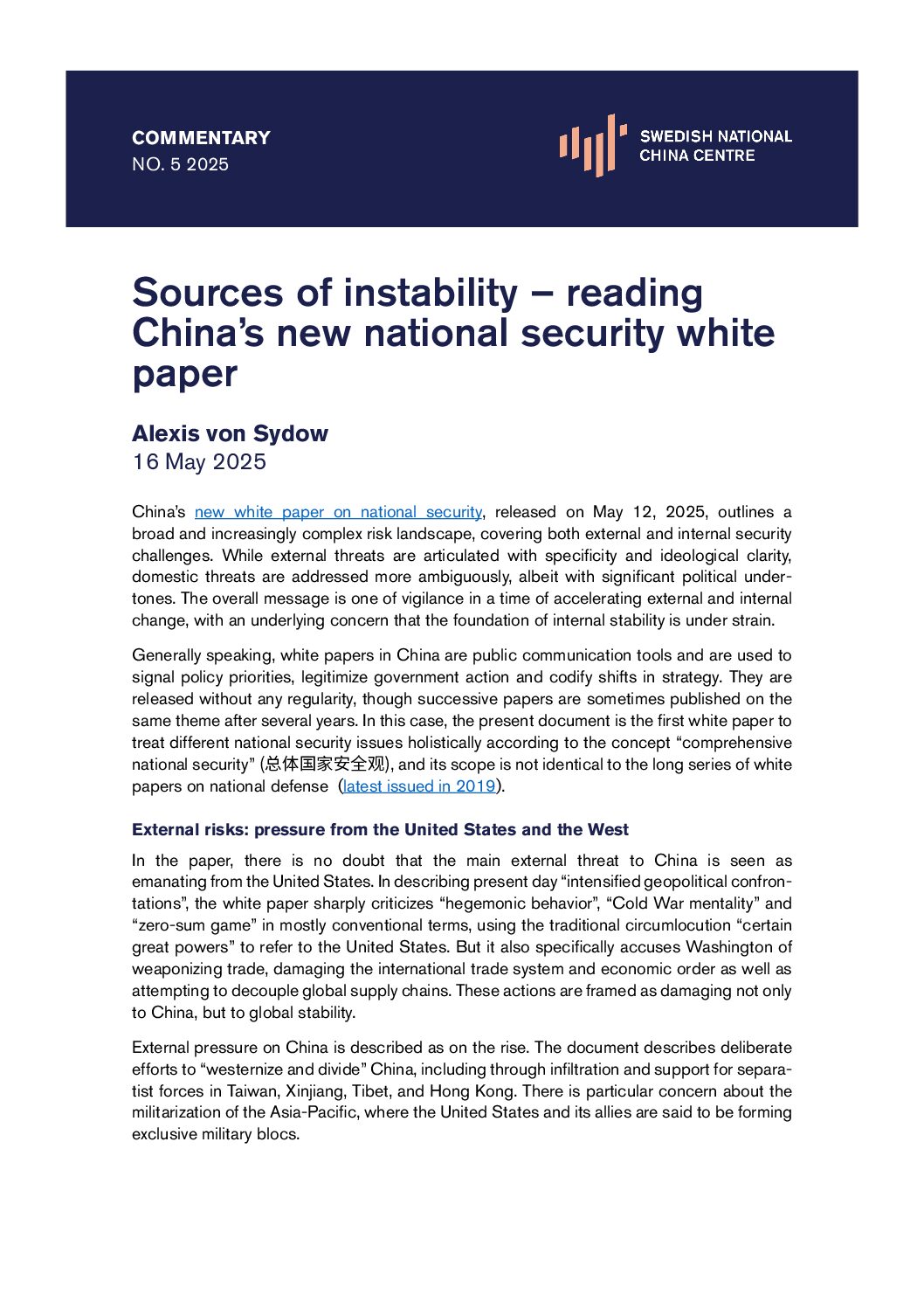
TT / Shutterstock
China’s new white paper on national security, released on May 12, 2025, outlines a broad and increasingly complex risk landscape, covering both external and internal security challenges. While external threats are articulated with specificity and ideological clarity, domestic threats are addressed more ambiguously, albeit with significant political undertones. The overall message is one of vigilance in a time of accelerating external and internal change, with an underlying concern that the foundation of internal stability is under strain.
Generally speaking, white papers in China are public communication tools and are used to signal policy priorities, legitimize government action and codify shifts in strategy. They are released without any regularity, though successive papers are sometimes published on the same theme after several years. In this case, the present document is the first white paper to treat different national security issues holistically according to the concept “comprehensive national security” (总体国家安全观), and its scope is not identical to the long series of white papers on national defense (latest issued in 2019).
External risks: pressure from the United States and the West
In the paper, there is no doubt that the main external threat to China is seen as emanating from the United States. In describing present day “intensified geopolitical confrontations”, the white paper sharply criticizes “hegemonic behavior”, “Cold War mentality” and “zero-sum game” in mostly conventional terms, using the traditional circumlocution “certain great powers” to refer to the United States. But it also specifically accuses Washington of weaponizing trade, damaging the international trade system and economic order as well as attempting to decouple global supply chains. These actions are framed as damaging not only to China, but to global stability.
External pressure on China is described as on the rise. The document describes deliberate efforts to “westernize and divide” China, including through infiltration and support for separatist forces in Taiwan, Xinjiang, Tibet, and Hong Kong. There is particular concern about the militarization of the Asia-Pacific, where the United States and its allies are said to be forming exclusive military blocs.
More optimistically, the white paper emphasizes the role of the Global South, depicting these countries as a growing stabilizing force in global affairs and key players in mankind’s shared future. In this context, China positions itself as a champion of global justice, multilateralism, and the post-WWII UN-centered international order, including a section on the Chinese “Global Security Initiative”. Obliquely criticizing the United States, it remarks that “no country can retreat to a self-isolating island”.
The document also contains a section on “security in new domains”, defined as areas emerging from technological innovation and application, referring to cybersecurity, data and AI security, and biological threats.
Internal risks: economic challenges and societal transformation
Unlike the sharp tone used in the sections treating external threats, internal security concerns are presented in more veiled, conceptual language. However, key themes still emerge. The white paper places the survival of the Communist Party and the socialist system above all else. Any erosion of Party control is depicted as an existential threat that would lead to national disintegration. The Party’s absolute leadership over national security work is reaffirmed, with emphasis on centralized command, coordination, and ideological loyalty.
The paper notes a “complex internal situation” with increasing risks and challenges (内部风险挑战增多的复杂形势), likely pointing to economic pressures and societal transformation as underlying causes. There seems to be an implicit worry in the document that economic stagnation and growing public dissatisfaction may undermine the Party’s legitimacy. Internet use and its associated shifting social norms are flagged as destabilizing forces: changes in communication, values, psychology, and behavior are viewed as potential threats to social stability. The paper remarks that “problems after development are not fewer than before development”, signaling vigilance regarding the economic development so earnestly pursued: success always brings new risks, and present achievements are no guarantee of future stability.
But despite that formulation, failure to develop is framed as a threat to national survival. Conversely, security is a precondition for continued development. The text references a long list of major risks including financial instability, especially related to the real estate sector and local government debt, as well as food and energy security. Economic measures, like the issuance of special sovereign bonds, as well as the goal to improve “the people’s sense of benefit” (群众获得感), are framed in security terms.
Great emphasis is also placed on technological self-reliance, framed as both an economic and security imperative. The call for “high-level scientific self-sufficiency” (高水平科技自立自强) reflects anxiety over dependence on foreign technology. But a high technological level is also seen as introducing new risks. In the context of adopting new technologies and ways of production, advanced technologies are described as “a double-edged sword.” The document here notes a need to balance “fairness and efficiency, capital and labor, technology and employment” – likely a reference to China’s rapidly growing unemployment problems and the instability they create.
Geopolitical perspectives
The white paper also contains a brief geopolitical outlook, where China seeks to portray itself as a stabilizing global actor that tries to avoid militarization and economic decoupling and instead promotes multipolarity. Relations with key regions are described in pragmatic terms. The relation with Russia is described as a deepening strategic partnership. Relations with the United States are described as cooperative if there is mutual respect, but China’s red lines are also outlined with a warning against crossing them. Europe is described simply as a partner, whose strategic autonomy China supports, while ASEAN countries are portrayed as partners in the effort to uphold peace in the (territorially contested) South China Sea. The Global South is seen as natural partners to construct a global development and governance order. Active conflicts like Ukraine, Israel-Palestine, and Myanmar, and flashpoints like the Korean Peninsula are acknowledged, but framed as external crises rather than core Chinese concerns.
A regime in preemptive defense mode?
Overall, the white paper projects growing insecurity behind a façade of strength. The text emphasizes unity and vigilance, both outwardly (against Western encirclement) and inwardly (against social fragmentation, economic stagnation, and ideological drift). While the document insists on continued development and reform, it also signals that the costs of maintaining stability are rising—financially, socially, and politically. At its core, the white paper seems to betray a deep concern that the Party’s grip is not as firm as it once was, and that the transition from high growth to structural management, in an environment of growing external threats, may unleash unpredictable forces. The great emphasis put on prioritizing regime security is traditional, but also suggests that the leadership is bracing for a more volatile future that may require extraordinary defensive measures.
关于作者


